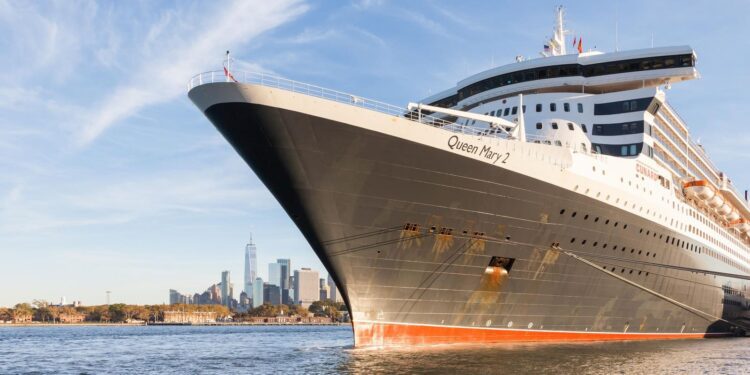Cunard Line’s ‘Queen Mary 2’, the world’s only remaining ocean liner, runs a regularly scheduled Transatlantic crossing.
getty
Why spend seven hours flying across the Atlantic when you can use an entire week instead? That’s the mentality of passengers on Cunard’s Queen Mary 2, the world’s only remaining true ocean liner.
But the storied Cunard Line is not the only way of experiencing an Atlantic crossing. Here are all your options for experiencing this historic travel route for yourself, starting with the one that features on many cruise travelers’ bucket lists.
Cunard Line
Cunard’s Queen Mary 2 offers the classic transatlantic experience, sailing regularly between Southampton and New York. With her deep hull and sleek design, she was built to handle the sometimes choppy waters of the Atlantic, ensuring a smoother ride than most traditional cruise ships.
Queen Mary 2 has modern amenities, but its heart and soul remains rooted in a luxurious past. The week-long journey is a step back in time to the golden age of ocean travel, before the advent of the jet liner changed everything.
Passengers can expect afternoon teas, formal dress codes for dinner, and grand ballroom dancing. If you want to embrace the romance and tradition of crossing the Atlantic by sea, there are few better options.
Looking to save money? Book an inside cabin. This isn’t a Norwegian fjords or Alaska itinerary with endless sights to see from your own private space.
Although the sail-in to New York on the westbound leg crossing is one of the iconic ocean travel experiences, it alone isn’t worth splashing out thousands of extra Dollars when you can enjoy it from the spacious outside decks.
Something else to bear in mind is that westbound itineraries give you an extra hour on most days because of the almost daily time zone changes.
Repositioning Cruises
If Cunard’s regular crossings aren’t your style, there’s another way to experience a transatlantic voyage—by hopping on a repositioning cruise.
Many cruise lines relocate their ships between Europe and the Americas twice a year, in the spring and fall. Rather than sail them empty, each line tends to offer unique one-way itineraries at bargain prices.
These repositioning cruises often come with unique perks: fewer crowds, more sea days to relax, and often some unexpected ports of call, like the Azores or Bermuda.
Major lines like Royal Caribbean, Norwegian Cruise Line, and Celebrity Cruises all offer these seasonal voyages, which are perfect for those looking for a blend of adventure, relaxation, and a cost-effective way to cross the Atlantic.
A word of caution though: be sure to factor in the cost of a one-way flight when evaluating the overall value of the deal.
Longer Itineraries
By their very nature, world cruises and grand voyages cross oceans, offering passengers the chance to explore multiple continents over the span of weeks or even months.
Holland America Line is one cruise line that offers multiple transatlantic crossings.
Universal Images Group via Getty Images
Of course, these types of cruises come with a hefty price tag and are usually priced out of the reach of most cruisers, instead appealing to wealthy retirees or individuals with flexible schedules and ample resources.
However, to ensure the ships are as full as possible, many cruise lines offer segments of world cruises or longer, one-off, taster voyages that give people the chance to experience the luxury and adventure of an extended cruise without the commitment and expense of a world cruise.
Holland America is one line known for its transatlantic crossings, both repositioning but also one-off themed itineraries. This 35-day Voyage of the Vikings is a roundtrip summer cruise from Boston that takes in Newfoundland, Greenland, Iceland, Norway, and the British Isles. Because of its northerly routing, there’s never more than two consecutive days at sea.
Another option is one-off itineraries from some cruise lines, often in shoulder seasons. For example, Fred Olsen Cruise Lines offers a 26-day trip to allow its predominantly British guests to enjoy Canada in the Fall, featuring five sea days in both directions.
In most cases, including the two examples above, shorter one-way trips are available with flights for the return.
Before You Book A Transatlantic Cruise
So, what are you waiting for? Well, before rushing out to book a great deal, it’s important to know that a transatlantic cruise has its quirks.
First and foremost, it’s not a good idea to pick one for your first cruise as there’s a heightened risk of motion sickness when sailing on the open ocean for days at a time. If you’ve never experienced the motion of the ocean, perhaps choosing a shorter cruise with more port days might be a better first move.
While for many people a cruise is all about the itinerary and ports of call, the choice of ship is much more important on ocean crossings. You’ll be spending several consecutive days with nowhere else to go, so make sure the ship has the facilities you want.
If you plan on relaxing in the spa, or dining in a specific premium restaurant, book in advance to avoid disappointment.
Finally, be prepared for unpredictable weather. The Atlantic can be calm, but it’s not unusual to encounter storms or rough seas, especially in spring and fall. Of course, that’s when repositioning cruises are much more likely to take place.
MORE FROM FORBESForbesHow To Pack Smartly For Your Next Cruise VacationBy David NikelForbesWhy You Should Consider A Small Ship For Your Next Cruise VacationBy David NikelForbesWhich British Cruise Line Is Right For You?By David Nikel
Source link : http://www.bing.com/news/apiclick.aspx?ref=FexRss&aid=&tid=670537dcbcd840ee9515dd3df37152d5&url=https%3A%2F%2Fwww.forbes.com%2Fsites%2Fdavidnikel%2F2024%2F10%2F08%2Fhow-to-plan-a-memorable-transatlantic-cruise%2F&c=4642299477506592358&mkt=en-us
Author :
Publish date : 2024-10-08 00:43:00
Copyright for syndicated content belongs to the linked Source.












